JSS University Mysore 2025
NAAC A+ Accredited| Ranked #24 in University Category by NIRF | Applications open for multiple UG & PG Programs

The topic PCR is from the chapter Biotechnology: Principles and Processes. According to the analysis of the past five years' NEET papers, 20 questions were asked from the chapter - Biotechnology: Principles and Processes, which has approximately 9% weightage of the total questions asked from Zoology. Out of 20, five questions were based on the PCR concept alone. You will find those questions from PCR at the end of the article. Let's understand the PCR in detail.
The polymerase chain reaction, commonly referred to as PCR, is a technique used to create multiple copies of a certain segment of DNA in vitro. Kary Mullis, an American biochemist, developed this technique in 1983. PCR technique is used to generate millions of copies of a DNA segment. It allows the scientist to amplify a very small DNA sample to a large amount for a detailed study. PCR is usually used in biotechnology labs, several areas of biology and in medicine such as medical diagnostics, molecular biology research and even in some areas of ecology. The goal of PCR is to produce amplified DNA so that it can be analysed or used.
DNA Template - The DNA of interest to be amplified.
Taq Polymerase - It is a DNA polymerase I. PCR requires the enzyme DNA polymerase to synthesise new strands of DNA. The DNA polymerase used in PCR is known as Taq polymerase. As it is isolated from the heat-tolerant bacterium Thermus aquaticus, this enzyme can withstand high temperatures.
NAAC A+ Accredited| Ranked #24 in University Category by NIRF | Applications open for multiple UG & PG Programs
T. aquaticus resides in hot water springs and its DNA polymerase is heat stable and remains most active at about 70 degrees celsius - the temperature at which DNA polymerase of E. coli and humans would be non-functional. As the high temperature is repeatedly used in PCR to denature the DNA strands, the Taq polymerase is considered ideal for PCR due to its high heat stability.
Primers -
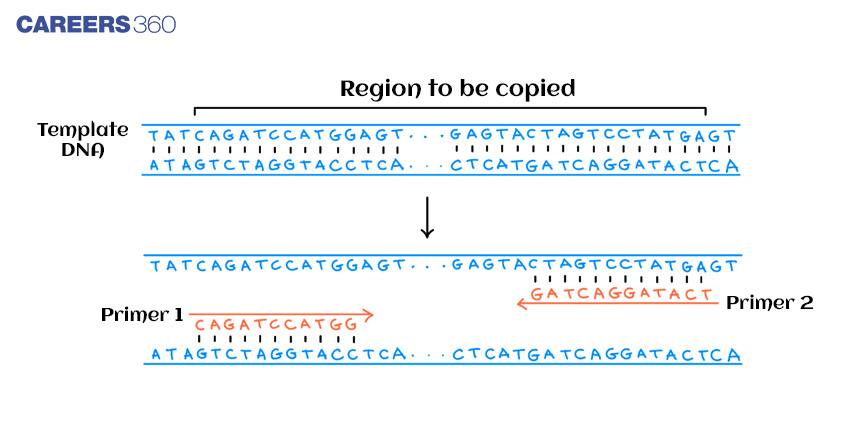
They are short chemically synthesised oligonucleotides, single-stranded DNA complementary to that particular segment of DNA to be amplified. The 2 primers that are used in each PCR are designed in a way to flank the target region of the DNA - region to be copied or amplified. The primers bind to the template strand via complementary base pairing. After binding they can be extended due to the action of DNA polymerase.
dNTPs - It is deoxyribonucleotide triphosphate, the building block to synthesise DNA. The energy required for the polymerisation is provided by them as well. The four common dNTPs used in PCR are adenine (dATP), thymine (dTTP), cytosine (dCTP), and guanine (dGTP).
Buffer - Potassium and Magnesium present in the buffer solution provide optimum conditions for denaturation and renaturation of DNA. Buffers also play an important role in polymerase activity, stability, and fidelity.
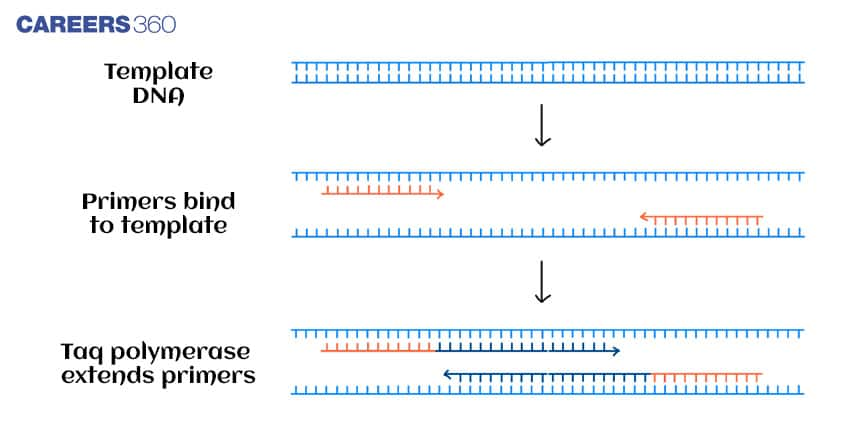
The technique is based on the replication of DNA using enzymes and majorly relies on thermal cycling. A particular segment of DNA is amplified in vitro - in an artificial environment outside the body - to make new strands of DNA using the existing strand as a template, enzyme Taq DNA polymerase and two sets of primers. This particular segment of DNA to be amplified can be a gene of interest for a researcher, a genetic marker used in forensic science to match the DNA from the crime scene with that of the suspects or a gene whose function is to be determined by the experimenter.
What are the steps in correct order involved in a polymerase chain reaction?
The key ingredients used in polymerase chain reaction are template DNA, primers, DNA polymerase i.e. Taq Polymerase, and nucleotides - the DNA building blocks. All the ingredients are kept in a tube along with the co-factors required by the enzyme. Then the tube goes through the repeated cycle of heating and cooling and thus new strands of DNA are synthesised from the template DNA.
What has happened inside the tube due to repeated heating and cooling?
Each cycle of PCR includes three steps:- 
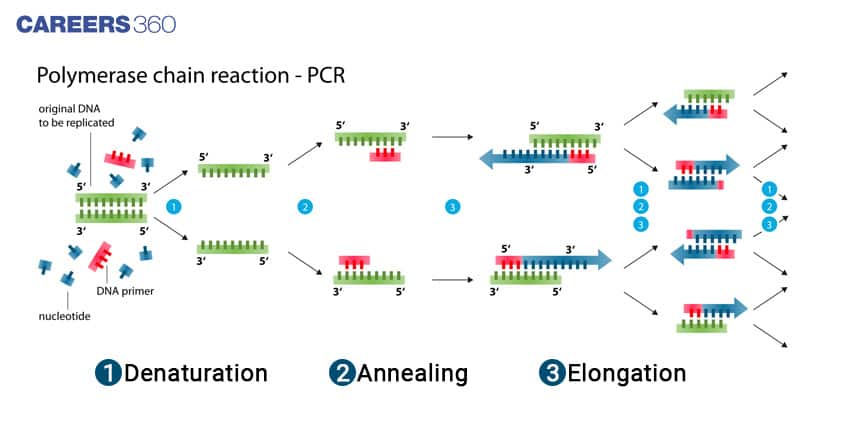
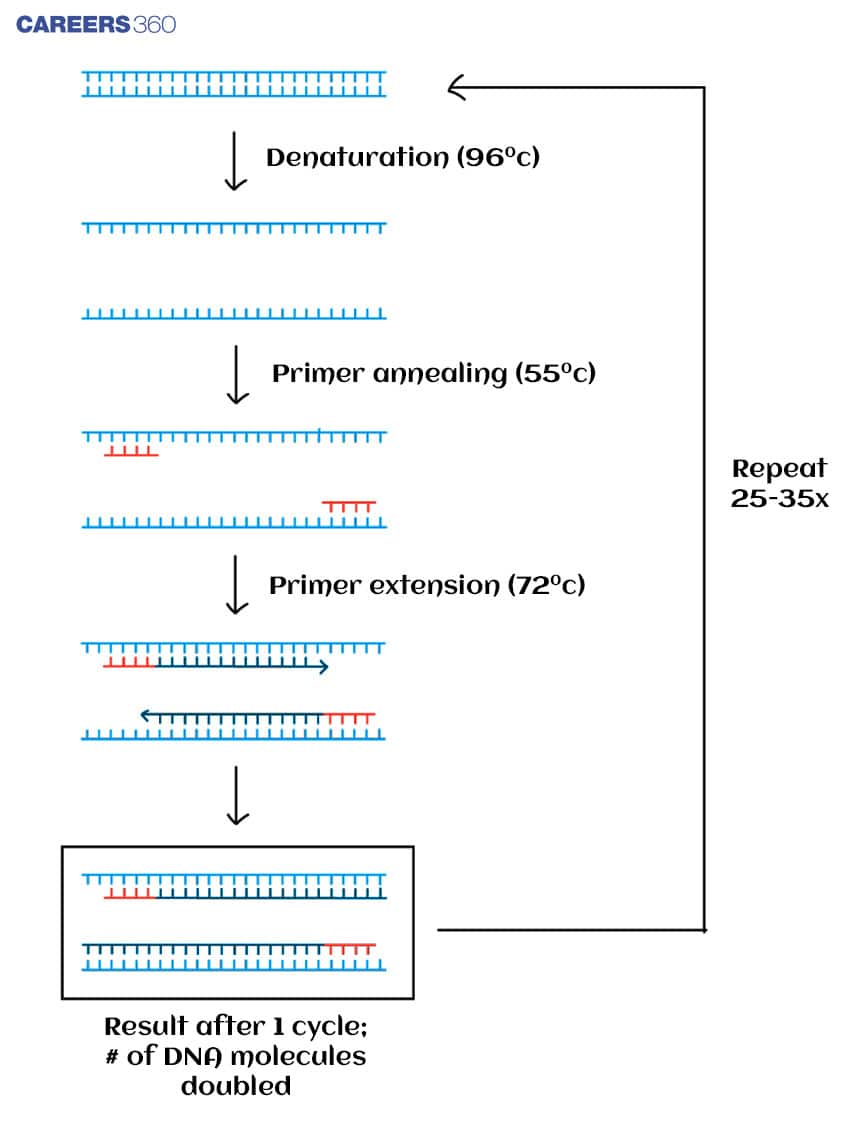
The first step is denaturation in which double-stranded DNA is separated by heating the sample. It takes place at about 94 degrees Celsius for about 30 seconds. At this temperature, the hydrogen bonds between the base pairs are broken and thus single-stranded DNA is obtained for the next step.
In the second step of PCR, the temperature is lowered up to about 54 to 64 degrees celsius. This cooling allows primers to bind their complementary sequences on the template strand. The two primers - a forward primer and a reverse primer - bind to the 2 separated template strands running in opposite directions. After complementary base pairing, DNA polymerase binds at primer-template hybrid and initiates the DNA synthesis. Thus, primers act as initiating points for DNA synthesis.
In this step, the temperature is again raised to 72 degrees celsius. For elongation or extension, a thermostable DNA polymerase is used - Taq polymerase. Taq Polymerase extends the primers by adding the nucleotides - 1000 base pairs per minute under the optimum conditions - in the 5’ to 3’ direction and thus the complementary strand of the DNA template is synthesised. As a result of 1 cycle of PCR, a double-stranded molecule is obtained in which one is a newly synthesised strand and another is an original strand.
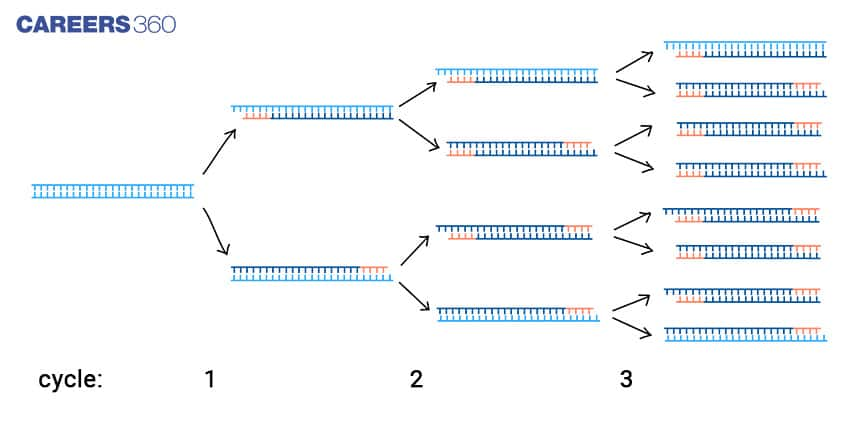
This cycle of 3 steps is repeated many times to get billions of copies in a very short period. In a typical PCR reaction, the cycle is repeated 25–35 times and it usually takes 2-4 hours. However, the time taken depends on the number of cycles and the length of the DNA region to be copied. The results of PCR can be visualised using gel electrophoresis.
The original DNA segment is not used as a template each time. The newly formed DNA in one round can serve as a template in the next round. Numerous molecules of Taq polymerase and copies of primers float around the reaction. So, molecules of DNA roughly double in each round of cycling as shown in the diagram above.
PCR is applied in many research labs as an essential tool in research and biotechnology. It has numerous practical applications in diagnostics, forensics, and genetic testing. PCR is a susceptible technique and provides results rapidly. The desired gene can be turned into millions and billions of copies that can be utilised for several purposes such as analysis, cloning and sequencing. Some of the essential applications in various fields are given below:
PCR can be used to diagnose the presence of a viral or bacterial genome in the host cell even before the onset of the disease. For example, the viral load can be detected using the PCR technique: RT-PCR is used to detect the presence of the SARS-CoV-2 viral genome.
To compare the genome of two organisms in genomic studies
To study gene expression
Gene Mapping
To create the mutant genes to study site-directed mutagenesis
Used as a tool in genetic fingerprinting.
Identifying the criminal from the suspects- A small DNA sample collected from the crime site can be amplified to analyse and compare with that of the suspects
Paternity tests
The gene of interest is amplified using PCR and then inserted into a vector for cloning.
Ancient DNA samples can be detected and analysed using PCR
Question 1: What is PCR?
Answer: It is a technique used to create multiple copies of a certain segment of DNA in vitro. Kary Mullis, an American biochemist, developed this technique in 1983. Generating millions of copies of a DNA segment has been possible because of the PCR technique. It allows the scientist to amplify a very small DNA sample to a large amount for a detailed study.
Question 2: The correct order of steps in Polymerase Chain Reaction (PCR) is________. (NEET 2018)
Answer: The correct order in which polymerase chain reaction takes place is:
Denaturation
Annealing
Elongation or Extension
Question 3. What is the importance of PCR?
Answer: PCR is applied in many research labs as an essential tool in research and biotechnology. It has numerous practical applications in diagnostics, forensics, and genetic testing. PCR is a susceptible technique and provides results rapidly. The desired gene can be turned into millions and billions of copies that can be utilised for several purposes such as analysis, cloning and sequencing.
Question 4: During the process of gene amplification using PCR, if a very high temperature is not maintained in the beginning, then which step of PCR will be affected first? (NEET 2021)
Answer: Denaturation
In denaturation, the double-stranded DNA is separated by heating the sample. It takes place at about 94 degrees celsius for about 30 seconds. At this temperature, the hydrogen bonds between the base pairs are broken and thus single-stranded DNA is obtained for the next step.
Question 5: Which of the following is not an application of PCR (Polymerase Chain Reactionando)? (NEET 2021)
(A) Molecular diagnosis
(B) Gene amplification,
(C) Purification of the isolated protein,
(D) Detection of gene mutation.
Answer: (C) Purification of the isolated protein.
Some important areas of application of PCR are given below:
(i) Diagnosis of pathogens
(ii) Diagnosis of a specific mutation.
(iii) DNA fingerprinting
(iv) Detection of specific microorganisms
(v) In prenatal diagnosis
(vi) Diagnosis of plant pathogens
(vii) In palaeontology
On Question asked by student community
Hello aspirant,
Students can finish their NEET preparation and pass the test with flying colors thanks to the mock exams. For NEET, NTA offers test papers and online practice exams. To assess their level of preparation, students must rehearse the exams. After completing the test, assess and analyze it to determine ways to raise your score.
To get the sample papers, you can visit our site through following link:
https://medicine.careers360.com/articles/neet-sample-paper
Thank You
First, understand the NEET syllabus clearly for Physics, Chemistry, and Biology. Focus only on the NCERT syllabus, as most NEET questions are directly or indirectly based on NCERT, especially in Biology and Chemistry. Avoid unnecessary reference books at this stage.
Divide your 4 months into phases. In the first 2 months, focus on completing the entire syllabus. Study Biology daily, as it carries the highest weightage. Read NCERT Biology line by line, make short notes, and revise regularly. For Chemistry, give priority to NCERT for Inorganic and Organic Chemistry. Practice basic numericals and reactions consistently. In Physics, focus on understanding concepts and practicing standard questions rather than memorizing formulas.
In the third month, start intensive revision along with topic-wise and full-length mock tests. Analyze each test carefully to identify weak areas and work on them. Improve time management and accuracy during this phase.
In the last month, focus mainly on revision and mock tests. Revise NCERT multiple times, especially Biology diagrams, tables, and examples. Avoid learning new topics at the last moment. Maintain a proper sleep schedule and take short breaks to avoid burnout.
Stay consistent, avoid distractions, and believe in your preparation. Even a few focused hours daily with proper planning can make a big difference. All the best!
Scoring 600+ marks in NEET within 4 months is definitely challenging, especially if you are starting almost from scratch, but it is not impossible. It largely depends on your discipline, daily study hours, clarity of basics, and how smartly you plan your preparation.
First, you need to be very realistic and focused. In 4 months, your main goal should be to strengthen NCERT-based concepts rather than trying to study everything in extreme detail. NEET questions are largely NCERT-oriented, especially in Biology and Chemistry. If you can master NCERT thoroughly, your chances improve significantly.
Biology should be your top priority because it carries the maximum weightage and is comparatively scoring. Read NCERT line by line for both Class 11 and 12. Revise multiple times and practice MCQs daily. Even if Physics feels tough initially, focus on high-weightage and formula-based chapters like Modern Physics, Current Electricity, Semiconductors, Ray Optics, and Laws of Motion. Chemistry can be divided smartly: give more time to Organic and Inorganic NCERT, and practice numericals regularly for Physical Chemistry.
You should ideally study 10–12 focused hours daily with a fixed timetable. Daily revision and weekly full-length mock tests are extremely important. Initially, your mock scores may be low, but what matters is consistent improvement and learning from mistakes. Analyze each test carefully to understand weak areas.
Since you are already enrolled in another college, time management becomes even more important. Try to minimize distractions and use early mornings or late evenings effectively. Avoid too many reference books; stick to NCERT and one reliable question bank.
That said, aiming for 600+ in 4 months is ambitious and depends on your learning speed and consistency. Even if you fall slightly short, a strong score improvement can still open opportunities in government or private colleges depending on category and cutoff trends.
Stay disciplined, trust the process, and do not compare your journey with others. Many students have made significant jumps in short durations with focused effort. All the best.
Hello,
Here are the important naming reactions for the NEET preparation.
Naming Reaction for NEET Preparation
Hope it helps your preparation. Good luck.
Hello
If you are asking about Motilal Nehru Medical College (MLN Medical College), Prayagraj, then admission is strictly through the NEET exam. For MBBS in this medical college, students usually need a high NEET rank because the cutoff is quite competitive.
In recent years, the closing ranks have often been within the top 20,000–30,000. This means you need a strong score to secure a seat. The exact marks may change every year depending on difficulty and competition.
You can get more information by visiting Careers360.com.
Ranked as India’s #1 Not for profit pvt. University by India Today | Wide Range of scholarships available
NAAC A+ Accredited| Ranked #24 in University Category by NIRF | Applications open for multiple UG & PG Programs
Among top 100 Universities Globally in the Times Higher Education (THE) Interdisciplinary Science Rankings 2026
Amongst top 3% universities globally (QS Rankings) | Wide Range of scholarships available